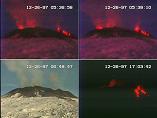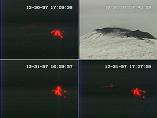CNN images of 13 January 1998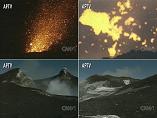 Four frames taken from the 13 January 1998 CNN movie showing Strombolian activity at SE Crater (top frames), Bocca Nuova and NE Crater (bottom frames). The Bocca Nuova frame is from the northwestern rim of the crater and shows the "diaframma", the narrow wall between Bocca Nuova and Voragine, in the center; the crag looming on the right side is what remains of the southern cone of 1964. To see the full movie, click here (attention: 2.2 MB file!). SE Crater, 13 January 1998 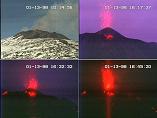 Frame at top left (1115 local time) shows daylight view, the other frames were taken shortly after sunset and during nightfall (between 1717 and 1745) and show close-ups of the intracrater cone of SE Crater and lava flows on the upper flanks of SE Crater. Note powerful explosion in lower right frame. SE Crater, 12 January 1998 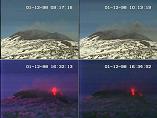 Top frames (taken at 1017 and 1113 local time) show ash emission from Bocca Nuova and NE Crater (right frame); bottom frames show strong lava jets and three active flows at SE Crater (taken at 1732 and 1734, respectively). SE Crater, 9 January 1998 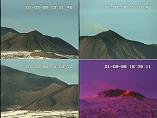 Top frames and bottom left frame show details of SE Crater, its intracrater cone and the active flank on the southwestern flank; bottom right is a view at dusk. SE Crater, 7 January 1998 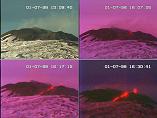 Top left taken during daylight (at 1609 local time). After sunset, the active southwestern flow and Strombolian activity from the central cone become increasingly evident (frames taken at 1708, 1718 and 1731 local time).  Mosaic composed of two telecamera images taken at about 1715 local time, showing detail of SE Crater and the lava flow on its southwestern flank. Strombolian activity is showering central cone with bombs. 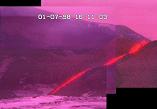 Detail of the lava flow on the southeastern flank of SE Crater is visible in this mosaic composed of three telecamera images taken at about 1712 local time. Flow front is hidden behind a low ridge.
|
SE Crater and Bocca Nuova are continuing their vigorous and spectacular activity. With worsening weather conditions, visual observations are again difficult but the situation is stable and there are no indications of significant changes in the near future. Since we're dealing with an active and very complex volcano, however, changes may occur at any time and very rapidly - keep this in mind when referring to the updates provided here (especially when "Italy's Volcanoes" is in repose for the weekend)!
29 January 1998
Vigorous and spectacular activity is continuing at SE Crater and Bocca Nuova, thus marking the continuation of the long-lived summit eruption initiated two and a half years ago. During the evening hours of today, Strombolian activity is occurring from the intracrater cone at SE Crater while a lava flow is spilling down on the southeastern flank of the SE Crater cone. Incandescent blocks are frequently rolling beyond the base of the cone. At Bocca Nuova there are periods of an intense incandescence indicating that vigorous but intermittent activity is taking place there; this activity appears to involve both the southeastern and the northern eruptive centers, the former being the more vigorous. No particular seismic activity is presently occurring and Etna seems to have returned to stable conditions for the moment.
In these days there is frequently bad weather in the summit region of the volcano, rendering visual observations difficult, and visits to the summit are dangerous not only for the intense eruptive activity but also for the risk of being surprised by deteriorating weather and losing orientation on the mountain. This has recently happened to various groups of visitors, some of them being tourists who were attracted by the intense, and partly misleading, media coverage of Etna during the past two weeks. Visitors hiking to the summit should be aware of the risks and try to know the most recent weather forecasts for the area. In any case, the summit of Etna will be difficult to reach until March or April.
28 January 1998
During the past five days, bad weather has frequently prevented visual observations of Etna, and much snow has fallen in the summit area. It is assumed that the activity which resumed at the summit craters on 22 January has continued in this period. Today at daylight, Etna was plainly visible, and it appeared that explosive and effusive activity from SE Crater were continuing vigorously. A black lava tongue was visible on the southeastern flank of the cone, extending downslope to the western rim of Valle del Bove; some material may have spilled down the steep western side of Valle del Bove to a few hundred m below its rim. No evidence of active lava inside Valle del Bove was found. Bocca Nuova is emitting white steam with some dark ash plumes derived from collapse of the crater walls.
At dusk, (shortly before 1800 h local time) there is vigorous explosive activity at SE Crater; two small lava flows are visible on the flanks of the intracrater cone; bright but fluctuating incandescence over the southeastern vents in Bocca Nuova indicates that there are strong and long-lasting explosions.
22 January 1998
After two days of weak or absent eruptive activity, SE Crater resumed its Strombolian activity today. Shortly before 1800h local time, a few clear shots from the IIV telecamera showed incandescence at the crater. Shortly thereafter, a bright glow was also visible at Bocca Nuova. Meanwhile, magma continues to accumulate at depth, causing the volcano to inflate. Volcanologists monitoring Etna, local authorities, civil protection services and military personnel are meeting frequently to discuss the activity and to develop possible eruption scenarios and mitigation procedures. The continued inflation of the volcano may lead to an eruption on the flanks which could seriously endanger communities in the affected sector. however, there has been no significant seismic activity in the past few days, indicating that at least for the time being the volcanic system is relatively stable.
21 January 1998
Etna's summit craters were quieter yesterday, and there was no significant seismic activity. In spite of the apparent lull in the activity, authorities and civil protection services in the Catania area are preparing for a possible emergency situation related to a forthcoming flank eruption. Although it is impossible at this moment to forecast the time, site and character of such an eruption, it will occur sooner or later somewhere on the flanks of the volcano.
20 January 1998
The eruption at Etna's summit craters is continuing with some fluctuations, involving SE Crater, Bocca Nuova and Voragine. The lava flow from SE Crater which moved towards the western rim of Valle del Bove apparently stopped shortly after noon, and no effusive activity was visible until the summit was hidden by dense clouds in the late afternoon. Explosions from Bocca Nuova were audible as far as Zafferana, some 8 km from the summit, but magmatic activity alternated with subsidence of the magma column that caused collapse, generating dense ash plumes. Weak Strombolian activity at SE Crater continued until the summit was veiled by clouds yesterday; today the cloud cover is persisting, and no visual observations of the activity are possible. Local press sources cite scientists of the Istituto Internazionale di Vulcanologia saying that there is a continuing risk of a flank eruption and that the mountain is inflating "like a panettone". Seismic activity is low but a tremor (focal depth about 2 km below the surface) occurred on the western flank yesterday morning shortly before 0600 h local time, and another located directly below the summit craters, shortly after 1300 h local time.
19 January 1998
Activity at Etna's summit craters continues. Press reports indicate renewed magmatic activity from Bocca Nuova and Voragine while SE Crater is visibly in activity as can be observed plainly well from Catania and with the IIV telecamera. Yesterday evening and this morning there were three active lava flows on the slopes of SE Crater, one on the southwestern, one on the southern and one on the southeastern side. The southeastern flow appears to be the most vigorous and its nose has arrived on the western rim of Valle del Bove at noon today. There had been considerable movement of this flow since earlier this morning, and provided continuing activity it will begin to spill down into Valle del Bove later today. However, the flow is of minor proportions and will not arrive in lower areas unless the activity increases dramatically. Very dense gas emission is occurring from Bocca Nuova (mostly caused by relative air humidity); some of these emissions contain ash. Seismic activity has calmed down from the high levels of the last week, this is interpreted as a return of more stable conditions similar to those persisting throughout much of 1997. For the moment, the unusually multifaceted and long duration summit eruption of Etna begun in 1995 is continuing.
16 January 1998
After two days of bad weather, Etna's summit is again visible, and the telecamera at the Istituto Internazionale di Vulcanologia shows the return of explosive and effusive activity at SE Crater. Strombolian activity is occurring (as of 1815 h local time) from the intracrater cone, and lava is flowing down the southwestern flank of the main SE Crater cone. The summit eruption thus continues, but it is not known if, and to what degree, the other summit craters are participating in this activity.
During the preceding 24 hours, seismic activity has been relatively low, with some isolated but very shallow earthquakes on the northeastern and southwestern flanks. There are no indications of eruptive activity in the summit area or anywhere else, this situation contrasting starkly with continued press reports that vastly exaggerate the level of activity and danger at Etna. The most dramatic, and entertaining, report was published today in Germany's most read (but by no means most serious) newspaper "Bild" which says that "the eruptions are increasing from day to day" (the contrary is the case), "on Thursday 15 January incandescent lava is flowing downslope" (no visible observations were possible on that day but there were no seismic indicators of any eruptive activity), "during the last major eruption in 1992 several villages were annihilated" (one house in the outskirts of Zafferana was overrun by the lava of that eruption), and "in the worst case, Catania, with 300,000 inhabitants, will have to be evacuated" (in this moment no one is considering such a possibility even though Catania has been repeatedly invaded by lava flows, most recently in 1669).
15 January 1998
Just after the posting of yesterday's update, seismic activity at Etna resumed with a series of about ten weak tremors below the western flank (Monte Palestra area) and several shocks on the southwestern slope, some five km above Biancavilla (the town most affected by the seismicity of last weekend). Earthquake hypocenters were about 6 km below the surface on the western flank but much shallower on the southwestern flank. The state of "pre-alarm" declared at the beginning of this week remains in vigor. Meanwhile, activity at SE Crater has dropped to very low levels: last night, very few and weak explosions from the intracrater cone were observed and no active lava was visible on the outer flanks of the crater. Today, weather has deteriorated and by nightfall there is heavy rain in Catania, Etna is shrouded in clouds and any activity in its higher areas will be difficult to observe directly with similar weather conditions persisting.
Today's issue of the local newspaper "La Sicilia" (the prime newspaper in Catania) has two spectacular photos of SE Crater in eruption at night, with the full moon in the background, taken on Tuesday evening.
14 January 1998
Seismic and eruptive activity are low today. The only visibly active crater is SE Crater which was vigorously active yesterdaybut showed a marked diminuition of its activity towards midnight. Today at nightfall SE Crater has very few and weak explosions while there is no active lava flow on its outer flanks. No glow is visible above Bocca Nuova. This is the lowest level of activity observed since about one year, and it is not clear how the volcano will behave next. Many recent eruptions have been preceded by seismic activity similar to that of the past few days, but the recent seismicity is peculiar in that it has been continuing for about one year without being followed by a flank eruption so far.
Two videos of Etna were posted on the CNN Web site in the past few days. Since movie files are removed from the CNN page after a short time, they are available on the MTU mirror of "Italy's Volcanoes" for the rest of all times. The first movie was probably shot on the last weekend, during the major seismic crisis, and shows pictures of an overflight of Etna's summit craters. The second movie appeared on CNN on 13 January and was probably shot on the 12th or 13th. At the beginning it shows spectacular Strombolian activity at SE Crater (with the full moon in the background!), then there is a panorama of Bocca Nuova (but the interior is not shown); the last bit shows two persons walking on a crater rim, probably Bocca Nuova. Attention! The movie files are large (1.8 and 2.2 MB, respectively). A preview of the latter movie can be viewed at top left.
13 January 1998
Another seismic swarm occurred below the western flank of Etna yesterday afternoon, with twelve tremors in 20 minutes, the strongest measuring 3.1 on the Richter scale. Epicenters were closer to the summit craters than those of the preceding swarm, and thus some 2-3 km east of Monte Palestra. Focal depths were, as in the preceding seismic crisis, about 4 km below the sea level. No damage was reported, and no significant change was noted in the eruptive activity at SE Crater which had three active flows moving down its southwestern, southern and southeastern flanks.
This evening, Strombolian activity at the intracrater cone in SE Crater is vigorous (see uppermost image from the telecamera of the Istituto Internazionale di Vulcanologia at left) while active lava is only visible near the crater rim in three places. A very faint glow has reappeared at the southeastern eruptive center in Bocca Nuova; this may indicate that magma is rising again in this crater. Strong ash emissions have occurred from Bocca Nuova throughout the day.
The seismic and eruptive activity of Etna is receiving widespread attention in local and international news media, with some reports being vastly exaggerated. There is, and has never been, a state of panic in any place near Etna, and damage (caused by the seismicity) has been limited to part of a church which already had been closed due to (non-earthquake related) damage suffered several years ago. Several schools were evacuated at the cumination of the seismic crisis of last weekend, but there has been no systematic evacuation in any place. Eruptive activity at SE Crater has continued in a completely unaltered manner with respect to past weeks and months, the only exception being the new directions taken by recent lava flows. People in the Etna area behave calmly, Catania city residents showing great interest while there is even some kind of indifference displayed by people living closer to the volcano.
12 January 1998
The most intense seismic crisis during the current eruptive cycle of Etna occurred during the past weekend and caused widespread news media attention. Between Friday (9 January) afternoon and yesterday, about 200 tremors occurred in an area on the western and southwestern flanks of the volcano. The strongest shock measured 3.7 on the Richter scale and damaged a church building in Biancavilla. No other damage or injuries were reported. Most epicenters were located in the area between Monte Nunziata and Monte Palestra, two ancient flank cones on the western flank. Although the crisis declined after Saturday afternoon, vigorous surveillance of the volcano continues.
Strong ash emissions from Bocca Nuova on Sunday morning indicated that further collapse ocurred in that crater, caused by the subsidence of the magmatic column. It is assumed that the magma intruded into a new fracture within the western side of the volcanic edifice, a process that may lead to an eruption from that flank. However, the diminuition of the seismic activity after Saturday afternoon shows that magma intrusion is no longer occurring at this moment although it may resume at any time. IIV scientists are cautious about making precise suggestions about a future flank eruption. The probability of such an eruption is considered high but by no means sure, and the volcano may well return to its persistent summit activity.
Today, ash emission from Bocca Nuova was near continuous, but strong ash emissions also occur from NE Crater. Activity at SE Crater continues with Strombolian bursts and emission of lava flows onto the southwestern, southern and southeastern flanks of the cone. The peculiar southwestern flow seems to be waning; during the past few days it has formed several minor lobes adjacent to the main one; the flow front seems to have reached the base of the 1971 "Observatory cone". The continuation of Strombolian and effusive activity at SE Crater indicates that the magma level is still high in this part of the summit area and furthermore illustrates that SE Crater and Bocca Nuova are acting fairly independently in this moment.
9 January 1998
The following is a summary of Etna's summit activity after 23 December 1997, with a report on a visit to the summit craters on 8 January 1998.
Activity at Bocca Nuova and SE Crater remained very vigorous through the end of 1997. The activity presented a marvellous display to residents of the Catania area and aroused some apprehension since there was intense seismic activity in the Zafferana area and on the western flank of the volcano. There were more than 100 tremors in the Monte Palestra area on the western flank between 24 and 26 December, and local press reports cited scientists from the Istituto Internazionale di Vulcanologia considering a flank eruption in the near future "a good possibility".
Intense glow was visible above the two eruptive centers in Bocca Nuova at dawn on 26 December but was much weaker on the evening of that day. A weak glow was visible over the eastern part of the crater on 31 December, and no observations of significant incandescence after that date are known. On the evening of 7 January, several jets of incandescent bombs rose over the southeastern crater lip, and a few bombs fell onto the remains of the 1964 cone.
Activity at SE Crater in late December and early January was the most spectacular of the current eruptive period. On 25 December, continuous Strombolian activity occurred from the central conelet and lava flowed down on the southeastern flank of SE Crater to its base, covering previously emplaced flows. Two active flows were visible on the southeastern flank on the morning of the 26th, but sometime during that day, a new flow began to spill down the southern flank, reaching about half way down by nightfall (at about 1800 h local time). Although bad weather persisted on the mountain on 27 and 28 December, it is assumed that this new flow continued; several short lava lobes were visible on the southern flank on the 29th, none of which had extended down to the base of the cone.
Sometime between early 29 and early 30 December, more flows spilled down the southern flank of SE Crater, and a more peculiar flow moved down on the southwestern flank, bifurcating on the lower slope. On the evening of the 30th, active flows were visible on the southern flank while the southwestern flow showed only incandescence in its upper part. On the evening of 31 December, incandescent lava was visible on the lip of SE Crater in many places while active flows were descending on the southern flank; this spectacular display greeted the population of Catania during the festivities of New Year's Eve.
Observations of the activity during the first week of January 1998 are scarse, but it is assumed that the southern lava flows ceased while the southwestern flow resumed. On 7 January, this latter flow was incandescent along its full length, with the western flow lobe extending to the base of the SE Crater cone.
Summit visit, 8 January 1998. All four summit craters were visited on 8 January, during exceptionally stable and warm weather. NE Crater was essentially quiet, with only light steam emissions from its central pit and some of the June-August 1996 vents in the SW part of the crater. Steam emission was more abundant, and at times pulsating, from a collapse pit in the southern part of the crater. This pit was also the site of frequent avalanching and rockfalls that generated plumes of brown ash. No fresh magmatic products were found in the vicinity of the central and southern pits whose interior could not be viewed due to the instability of their rims.
The cone in the central part of the Voragine was quiet with only slight emission of bluish gas. Its crater was horseshoe-shaped and open to the southeast; a small lava flow had issued from the open side of the cone and extended for a short distance around its eastern base. The vent on the southwestern side of the Voragine crater floor which was first observed on 6 November 1997 had enlarged and was surrounded by a low half-cone leaning against the base of the narrow wall separating the Voragine from Bocca Nuova. This vent produced weak explosions that mainly expulsed hot gas and few pyroclastics. When viewed from the eastern rim of the Voragine, the conduit of this vent was seen to be inclined southwestwards, diving below the septum between Voragine and Bocca Nuova.
The period of infilling of Bocca Nuova seems to have come to an, at least temporary, end. The large cone in the northern part of the crater floor had partially collapsed, thus creating a huge crater about 150 m in diameter. Frequent rockfalls occurred within this crater, indicating continued collapse. Subsidence of the cone and the adjacent crater floor had created a set of circumferential fractures several meters wide. The most recent activity of this eruptive center appears to have been the extrusion of a lava flow that covered the eastern and southeastern sides of the floor of Bocca Nuova. The vents at the southeastern eruptive center were the site of weak Strombolian explosions which occurred every 10-15 minutes; all ejecta fell back into the vents. Most, if not all, activity occurred from the lowermost vent in the southwestern part of the eruptive center. A complex cone around these vents had grown notably since the most recent visit on 6 November 1997, with the rim of the highest vent being at about the same elevation as the northern rim of Bocca Nuova. Large parts of the crater wall above the southeastern eruptive center had collapsed, probably before the most recent growth of the cone since all collapse debris were buried.
Whereas the overall impression of the activity in these three craters is one of a notable diminuition (the present level of activity is the lowest observed in six months), SE Crater was very active during the visit, with continuous Strombolian explosions from two vents at the summit of the intracrater cone and lava emission from its southeastern base. The summit of the cone - located at the eastern side of the two erupting vents - was distinctly (about 5-7 m) higher than the highest point ("Fortino") on the northeastern rim of SE Crater. Lateral growth of the cone was most significant in the northern and northeastern parts of SE Crater where all lava flows and effusive vents active between July and September 1997 had been buried.
The level of the lava field surrounding the central cone had risen significantly, causing overflows on the eastern, southeastern, southern and southwestern sides. Only a segment of the northeastern crater rim stands a few meters above the lava fill. The western and northwestern part of the crater rim still stand some 20 m above the lava field and the cone's base.
Three craters were present on the central cone, two of which were erupting. Activity would occur from only one of the vents at any given time while the other vent was completely silent. The northern vent would erupt rather silently, but it ejected bombs and scoriae onto the northern and northwestern crater rim and beyond. The southern vent produced loud bangs and showered the eastern and southeastern flanks of the cone with pyroclastics. There was very rarely simultaneous activity from both vents, only when activity waned at one and resumed at the other.
The effusive vent on the southeastern side of the cone had crusted over, and lava issued only on the southwestern rim of SE Crater where it overflowed, forming a narrow (1.5 m) flow with distinct lateral levees extending to the base of the SE Crater cone. The flow bypassed a cone formed in 1971 on its eastern side; when reaching the almost horizontal plain below the steep southwestern flank of SE Crater, it broadened and thickened notably and advanced slowly in the direction of the "Observatory cone" formed in 1971. Between 1200 and 1530 h on 8 January, the flow front advanced about 15 m over thick snow, forming an offshoot on the western side of the ca. 20 m wide lava front. None of the other flows on the southern flank of SE Crater showed any signs of movement or incandescence. These flows extend down almost to the gently sloping terrain at the base of SE Crater; some show distinct narrow flow channels. The distance from the Torre del Filosofo mountain hut to the nearest flow front is about 1 km or slightly less; the active flow does not threaten this structure.

